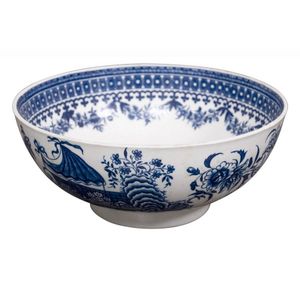Caughley Blue Chinoiserie Punch Bowl
You must be a subscriber, and be logged in to view price and dealer details.
Subscribe Now to view actual auction price for this item
When you subscribe, you have the option of setting the currency in which to display prices to $Au, $US, $NZ or Stg.
- Transfer Printed / Decorated Transferware - Transfer printing is method of decorating ceramics, reducing the cost of decoration when compared to employing artists to paint each piece. A print was taken on transfer-paper from an engraved copperplate, covered in ink prepared with metallic oxides, and the image on the paper was then applied to the biscuit-fired ceramic body. The print was fixed by heating the object in an oven, and then glazed, sealing the picture. Early transfer prints were blue and white, as cobalt was the only colour to stand firing without blurring. Early in the 19th century advances in the composition of the transfer paper resulted in better definition and detail, and enabled engravers to combine line-engraving with stipple.
- Circa - A Latin term meaning 'about', often used in the antique trade to give an approximate date for the piece, usually considered to be five years on either side of the circa year. Thus, circa 1900 means the piece was made about 1900, probably between 1895 and 1905. The expression is sometimes abbreviated to c.1900.
- Chinoiserie - Furniture and decorative items decorated in imitation of a Western interpretation of the Chinese style. The Chinoiserie style first became popular in the late 17th century, though there were frequent revivals, notably by Chippendale (hence 'Chinese Chippendale') during the Regency period, and the Anglo-Japanese style in the second half of the 19th century.
The ubiquitous 'willow pattern' is the most common 'Chinese' theme used in porcelain, while on furniture the Chinoiserie style usually has black or red painted and lacquered decoration, though the hallmark of the furniture style is the use of fretwork in geometrical patterns, pagodas and other decorative forms.
Japonaiseries, as the name implies, are motifs in imitation of the Japanese taste.
See also "Chinese Chippendale".
This item has been included into following indexes:
Visually similar items

A Chinese blue and white square vase, four sides decorated with flowers and insects, painted on the shoulder with stylised Ruyi head cloud patterns, early 17th century 25.1 cm high. Provenance: Rustam, Ujung Pandang, 1970's

A large blue and white bowl decorated on the interior and exterior with landscapes, Transitional period, first half of the 17th century, 16 cm high, 34.5 cm diameter. Provenance: Collection of Rajah Watan Bone, King of South Sulawesi Rustam, Ujung Pandang

Chinese blue and white porcelain bowl, of tapering lobed form, interior decorated with central roundel of fish, exterior decorated with fish, six character mark within double ring to base, diameter 20.5 cm

A fine Longquan celadon jar, 13-14th century, decorated with moulded band of peony on the shoulder, a band of lotus petals on the lower half, covered in a good pale green glaze, together with two similar Longquan jars, 11 cm high, 10.5 cm high and 17.5 cm
